Grown for their attractive foliage, pothos are a wonderful plant perfect for beginners or anyone who just wants a plant that isn’t too fuzzy.
Despite their easy-going nature, however, these popular houseplants are not immune to problems. If you’ve noticed your pothos leaves turning black, for example, don’t worry too much about it – this is a fairly common problem that occurs when the plant isn’t getting the right care.
So let’s see exactly what causes your pothos to have black leaves and, importantly, how to fix it!

Table of Contents
Why are my pothos leaves turning black?
Seeing black leaves on your pathos can be disheartening, especially since it is a sign that something is wrong with the plant. When your pothos have black leaves, it is usually due to overwatering. However, that isn’t the only issue that can cause leaf discoloration.
Usually, figuring out the exact culprit comes down to a process of elimination, as you’ll see.
1. Overwatering your pothos
The most common cause of pothos leaves turning black is overwatering the plant. While pothos do need water, giving them too much can cause the leaves to wilt and turn black, and increase the chance of root rot in your pothos and various other fungal diseases.
2. Inadequate drainage
Even if you’re not overwatering the plant, having poor drainage can cause the same effects as watering the pothos too much.
Black and/or wilting leaves, musty odor, soggy soil, water blisters, and stunted growth are all signs of poor drainage.
Find out more: Do Pothos Need Drainage? (4 Easy Tips So Your Plant Thrives)
3. Too much direct sunlight
If your pothos have black leaves, it could be that it is receiving too much sunlight or is sitting in direct sunlight. While your pothos needs light to thrive, both too much or too little can cause black or brown tips to form on the pothos leaves.

4. Over fertilizing
Too much of a good thing can end up being a bad thing, and over-fertilizing your pothos is the perfect example of this. Adding too much fertilizer will cause a wide array of problems for your plant, including black leaves, stunted growth, and burnt foliage.
5. Temperatures are too cold
Pothos is a tropical houseplant native to southeastern Asia and thrives in temperatures between 70 to 90 degrees Fahrenheit. When they are subjected to low temperatures, their leaves can start to turn black, wilt, and even experience stunted growth.
6. Not enough water
While too much water will obviously cause problems with your plant, so does not providing it with enough water. Underwatering your pothos will cause blackened leaves that may also be crispy and dry. If the plant continues to be deprived of water, it will eventually die.

7. Insect infestation
Insects are not just a problem for outdoor plants, they can also attack your indoor plants as well.
Sap sucking pests, such as spider mites, thrips, mealybugs, and aphids, use their sharp mouthparts to pierce the plant and suck out its juices. In extreme infestations, the pothos’ foliage can turn black, start to wilt, and fall off.
8. Diseases
While not as common as the other issues on the list, diseases can cause pothos leaves to turn black. Blight, for example, is a bacterial infection that can cause black spots to appear on pothos’ foliage as can bacterial leaf spot on your pothos.
The best defense against these fungal and bacterial diseases is to keep the plant healthy and avoid overwatering.
How do you fix black leaves on pothos?
The best way to fix black leaves on pothos is to take the necessary precautions so the plant has the proper care and growing environment. Once the plant starts to develop the black leaves, it becomes much harder to deal with the situation.
It’s always a good idea to give your houseplants a regular once over, just so you can catch any issues before they get out of control. This can also ensure you take action in the early stages of a problem forming.
1. Reduce the amount of water
Overwatering pothos is a common problem that is actually easy to avoid. Simply check the soil dryness before watering, and only water your pothos when the top 2 inches of soil starts to feel dry. When you do water, make sure to do so deeply.

2. Improve soil drainage
If your pothos have black leaves, it may be a sign that the soil isn’t properly draining.
When the soil is compact, the excess water cannot flow freely through it. This leads to soggy soil that leads to fungal problems and leaf discoloration.
Best soil for Pothos
Miracle-Gro Tropical Potting Mix
Light and well-draining (perfect for avoiding root rot) while being packed with just the right nutrients – that will feed your plant for up to six months. The best soil for keeping your pothos healthy and strong.
3. Remove the pothos from direct sunlight
Pothos do need sunlight to survive, but it has to be indirect light. Direct light will burn the plant’s foliage, causing stunted growth, leaf dropping, and various other symptoms.
Thankfully, you can easily rectify this problem by moving the plant out of direct sunlight.
4. Don’t over fertilize
When feeding your pothos, make sure to only apply fertilizer to your pothos during the plant’s active growing season, which is in the spring, summer, and fall.
Use a fertilizer that works specifically for your pothos’ needs, checking in particular that it has the right balance of nutrients.
Best fertilizer for Pothos
Jack’s Classic 20-20-20 All Purpose Fertilizer
A great fertilizer with the perfect balance for your pothos. Simply dissolve in water and feed your plant to watch it thrive.
Furthermore, only apply the recommended dosage as stated on the fertilizer bottle. Going over this recommended amount is one of the quickest ways to subject your plant to fertilizer burn, which can lead to the pothos leaves turning black.

5. Keep the pothos in the proper temperature
These native plants need temperatures that fall between 70 and 90 degrees Fahrenheit. They can, however, tolerate temperatures as low as 55 degrees, but they shouldn’t be subjected to these low temps for an extended period of time.
Furthermore, make sure to keep the plant away from areas where the temperature drastically fluctuates, such as near entryway doors and heating/cooling vents.
6. Don’t under water the pothos
The best way to avoid under watering your pothos is to simply water the plant when it needs it. Check for the soil dryness before watering and only water when the top 2 inches of soil begins to feel dry.
If the pothos has gone a long time without watering and the soil is extremely dry, watering it as you normally would may not be adequate since the water will just roll off the dry soil. Instead, submerge the pot in a bucket of water and let sit for about 20 to 30 minutes before removing it from the water. This will let the water penetrate the overly dry soil and give the plant a deep watering.
Find out more: How Often to Water Your Pothos (So It Thrives)
7. Take care of insects
Regularly inspect the pothos, examining the tops and undersides of the leaves, looking for any signs of insect damage.
When any signs of unwanted life are seen, take immediate action by liberally spraying the pothos with insecticidal soap. This is a safer alternative to chemically-filled pesticides and can even be used indoors.

8. Treat diseases ASAP
While it’s always best to prevent diseases from occurring to begin with, sometimes things happen and you are left with a diseased pothos. The good news is that you can usually treat the problem by spraying fungicide on the plant. Make sure, however, to quarantine the diseased plant away from your other houseplants to help prevent the disease from spreading.
In extreme cases, it may be better to get rid of a diseased pothos instead of keeping it indoors where it has the potential to spread bacterial or fungal diseases to your other plants.
Why are my pothos leaves turning black in water?
The main culprit when pothos leaves turn black is overwatering. Too much water leaves the plant’s roots soggy, which will result in fungal diseases that threaten the life of the plant. The leaves of an overwatered plant will start to turn black, or watery black and brown blisters will begin to form on the foliage and stems.
Avoid overwatering the pothos by simply inserting your finger into the top two inches of soil. If the soil feels damp or soggy, wait a couple of days before checking the moisture level. Only water the pothos when the soil begins to feel dry.
While overwatering the plant is easy to prevent, it can be difficult to fix. While merely overwatering the plant once or twice typically won’t cause any problems, continued overwatering requires repotting the pothos in a clean pot with fresh soil. You may also have to remove any damaged or diseased roots before placing the pothos in fresh soil.

Why are my pothos leaves turning yellow with black spots?
Pothos leaves that are turning yellow with black spots are a sign of severe overwatering. When it gets to this stage, simply reducing the watering frequency is not enough to correct the problem. The pothos will need to be repotted into a clean pot with fresh soil.
Repot the pothos by carefully sliding the plant and its soil out of the pot. Use your fingers to gently remove the soggy soil from around the pothos’ roots. Examine the roots and snip off any that are damaged or diseased.
Choose a pot that has drainage holes on the bottom, not on the sides. Fill the bottom layer of a clean pot with fresh, well-draining soil. Set the pothos on top of the layer of soil and then fill the remaining space with the soil.
Related: 9 Reasons Why Your Pothos Has Yellow Leaves (and How to Fix It)
Why are my pothos leaves turning black after repotting?
Pothos leaves turning black after repotting could be caused by poor soil drainage. Pothos need light and airy soil for healthy growth, and if they don’t get this they can experience symptoms associated with overwatering. For the best results, grow pothos in a mixture of perlite, peat moss, and vermiculite.
The container into which you repotted the pothos may be causing the black leaves. After all, what good is well-draining soil if it is in a pot that doesn’t have proper drainage? That is why it is vital to only plant pothos in pots that have holes at the bottom of the pot, and avoid containers with no drainage holes or holes along the sides.
Keep in mind, however, that leaves that have turned black due to overwatering will not revert back to their original color. New leaves, however, will grow normally as long as the plant is provided with the proper growing requirements.


